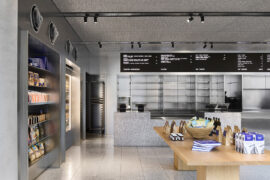Creating a sensory dining experience that fuses Japanese and Australian culture – rather than a “mock tradition” – Ishizuka by Russell & George transports diners while keeping their feet on the ground.
The obvious solution is seldom exciting. When the Japanese restaurant Ishizuka opened in Melbourne, the easiest design conceit would have been to pump it full of tradition – a direct visual link to the Kaiseki-style menu. But the team at Russell & George preferred a more distinctive point of view, opting instead for a playful, hybrid setting for a decidedly non-hybrid menu. “As the Melbourne context is a global one, we [knew] mock tradition wouldn’t work because a savvy diner can just go to Tokyo for that experience,” says Ryan Russell, director at Russell & George. “Evoking a memory of Japan was the starting point, but one that would be more atmospheric than literal.”
A large, egg-shaped lantern greets diners and cocoons the space with its encompassing scale, back-lighting a pattern of floral shadows. Beneath this, a subtly raised floor provides an important function – unusual in Kaiseki dining – of allowing guests to sit on chairs rather than raised bar stools. Throughout the darkly lit space, reimagined Japanese motifs are overlaid with references to more natural Australian landscapes. Traditional details are tempered with the relaxed dining overtures of the local context. The result of this precise yet abstracted pairing of cultures is an unexpected, unique and complete ode to not one, but two types of richness.
We think you would like this story on Japanese design. And for regular insights and updates, join our mailing list.
INDESIGN is on instagram
Follow @indesignlive
A searchable and comprehensive guide for specifying leading products and their suppliers
Keep up to date with the latest and greatest from our industry BFF's!

Rising above the new Sydney Metro Gadigal Station on Pitt Street, Investa’s Parkline Place is redefining the office property aesthetic.

For Aidan Mawhinney, the secret ingredient to Living Edge’s success “comes down to people, product and place.” As the brand celebrates a significant 25-year milestone, it’s that commitment to authentic, sustainable design – and the people behind it all – that continues to anchor its legacy.

Seven years in the making, the new Surry Hills Village is here with doors open and crowds gathering.

With its latest outpost inside Shanghai’s bustling Hongqiao International Airport, HARMAY once again partners with AIM Architecture to reimagine retail through colour, movement and cultural expression.
The internet never sleeps! Here's the stuff you might have missed

Architect, designer and craftsman Adam Markowitz bridges the worlds of architecture and fine furniture, blending precision, generosity and advocacy to strengthen Australia’s craft and design community.

IF Architecture crafts Baker Bleu Cremorne into a refined, sustainable bakery and café where industrial design meets artisanal warmth.